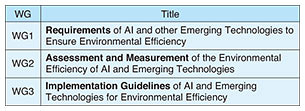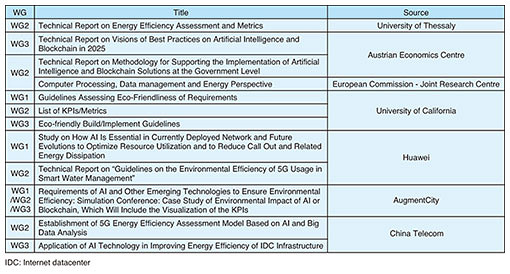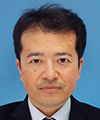 |
|||||||
|
|
|||||||
|
Global Standardization Activities Vol. 18, No. 9, pp. 48–52, Sept. 2020. https://doi.org/10.53829/ntr202009gls Meeting Report on ITU-T FG-AI4EE—ICT Applications Using Artificial Intelligence in Climate Change Countermeasures and Their Standardization TrendsAbstractAlthough emerging technologies, such as artificial intelligence (AI) and blockchain, are expected to improve service availability and work efficiency in various fields, they consume a large amount of energy during data collection from many sensors, learning, and data analysis. Therefore, it is necessary to evaluate the environmental impact as well as other effects of introducing such technologies. A short-term focus group in the International Telecommunication Union - Telecommunication Standardization Sector (ITU-T), Focus Group on Environmental Efficiency for Artificial Intelligence and other Emerging Technologies (FG-AI4EE), was established in May 2019 to conduct a preliminary study of the environmental efficiency of AI and other emerging technologies and held its first meeting in December 2019. This article describes not only what FG-AI4EE is and what was discussed at its first meeting but also how NTT has been working on environmental issues based on the Innovative Optical and Wireless Network (IOWN), including the response to crises such as the current COVID-19 pandemic. Keywords: environmental efficiency, AI and emerging technologies, focus group, ITU-T SG5 1. Environmental impact of artificial intelligence and emerging technologiesSociety 5.0 [1] proposed by the Japanese Cabinet Office aims to achieve economic growth and solve social issues in parallel by using a system that closely integrates cyberspace and physical space. Information distribution using artificial intelligence (AI), Internet of Things (IoT), big data, etc., is intended to enable a high quality of life. Natural disasters due to climate change have also been causing substantial damage worldwide, so it is necessary to develop effective methods for environmental protection using information and communications technology (ICT). In particular, AI and other emerging technologies, such as blockchain, edge/cloud computing, and fifth-generation mobile communication systems (5G), are expected to help solve such environmental problems by enabling near-future environmental prediction and visualization of meteorological phenomena. However, the energy consumption of AI and other emerging technologies is also expected to have an environmental impact due to the increase in the size of applications and amount of calculation, which is similar to that of current services and applications. Furthermore, AI consumes a large amount of energy not only when analyzing a large amount of data collected from sensors and system logs but also during pre-learning and tuning. Therefore, to minimize the environmental impact of using ICT, a method is required for evaluating and measuring the environmental efficiencies with respect to both ICT performance and environmental impact, which have not been defined by existing international standards and/or guidelines in the environmental field. 2. Purpose of establishing FG-AI4EEWithin the International Telecommunication Union (ITU) under the United Nations (UN), telecommunications carriers and ICT vendors are developing ITU-T Recommendations for guidance to solve various environmental issues regarding ICT in Study Group 5 (SG5) of the Telecommunication Standardization Sector (ITU-T). The methodology for assessing the environmental impact of the ICT sector has been completed as Recommendation ITU-T L.1450. In addition, Recommendation ITU-T L.1451, which was developed in 2019 with contributions from NTT, defines the method of assessing the aggregated positive environmental impact of ICT in other sectors. Since the quantitative evaluation of ICT’s potential contribution to environmental protection has progressed, a short-term Focus Group on Environmental Efficiency for AI and other Emerging Technologies (FG-AI4EE) was established in May 2019 to conduct a preliminary study called “Environmental Efficiency for AI and other Emerging Technologies.” FG-AI4EE started its activities to promote a global dialogue on the environmental efficiency of AI and other emerging technologies. Emerging technologies are expected to improve work efficiency and expand potential applications in various fields but consume a large amount of energy during installation and operation and increase environmental impact. To achieve the UN Sustainable Development Goals (SDGs), methods and global evaluation standards are needed to evaluate and measure the environmental impact of solutions that use emerging technologies. FG-AI4EE is expected to function as a platform for clarifying the standardization requirements for achieving the SDGs. 3. Overview of the first FG-AI4EE meetingThe first FG-AI4EE meeting was held in Vienna (Austria) from December 11 to 13, 2019. A workshop of the AI4EE Forum and a meeting of the U4SSC (United for Smart Sustainable City) index thematic group were held in conjunction with the FG-AI4EE meeting. Unlike the ITU-T SG5 meeting, the FG-AI4EE meeting involved not only telecommunications-related parties but also other entities: international organizations such as UN and government-affiliated organizations, and academic institutions such as universities and think tanks. About 30 participants attended the meetings in person, including two of the authors (Mr. Kondo and Mr. Sugimoto), and about 15 attended remotely from around the world. There were two sessions in the AI4EE Forum. The first session was held to explore the possible environmental impact of AI, and the second was devoted to discussing use cases for assessing such impact. During the forum, the necessity of AI and the goal of FG-AI4EE were shared among all participants. At the FG-AI4EE meeting, there were discussions regarding 1) management team, 2) working group (WG) structure, 3) terms of reference (ToR), and 4) FG deliverables to be developed. 3.1 Management teamThe FG chairpersons are Dr. Paolo Gemma (Huawei), who also chairs Working Party 2 of ITU-T SG5, and Dr. Neil Sahota (IBM & University of California). Professors and experts in the fields of finance/economics and environment/energy are among those named as vice-chairpersons. Table 1 shows the chairpersons and vice-chairpersons agreed at this meeting.
3.2 WG structureIt was agreed that the three newly established WGs shown in Table 2 would carry out detailed studies.
(1) WG1: Requirements of AI and other Emerging Technologies to Ensure Environmental Efficiency WG1 studies the requirements for improving environmental efficiency when introducing AI and other emerging technologies. In various use cases, introducing an emerging technology that fulfills these requirements would be expected to result in reduced energy consumption, which would reduce environmental impact. For example, key performance indicators (KPIs) such as bandwidth usage are collected from an optical line termination and optical network termination in a passive optical network (PON) system, then root-cause analysis using AI is carried out. This analysis would identify minimum required resources that satisfy the service-level agreement, which would in turn reduce the power consumption of the PON system and the number of on-site calls. (2) WG2: Assessment and Measurement of the Environmental Efficiency of AI and Emerging Technologies WG2 studies environmental efficiency assessment and measurement methods that help carriers and related stakeholders introduce AI and other emerging technologies. It would be expected that the outcome for achieving the SDGs can be attained by using the evaluation and measurement methods studied in WG2 to improve the quality of these technologies while considering their operational efficiency and environmental impact. (3) WG3: Implementation Guidelines of AI and Emerging Technologies for Environmental Efficiency WG3 studies implementation guidelines to improve the environmental efficiency of AI and other emerging technologies. Regarding blockchain, which supports crypto-currencies, the guidelines on how to improve environmental efficiency and the principle of environmental efficiency by the transition from “proof of work” (allowing more computationally intensive users to work more favorably) to “proof of stake” (not wastefully consuming energy even when competing with others) will be provided. 3.3 ToRFG-AI4EE will develop technical reports and technical specifications to address the environmental efficiency as well as water and energy consumption of emerging technologies to meet the SDGs. Specifically, the key objectives of the FG include the following.
3.4 Deliverables to be developedAt the first FG-AI4EE meeting, participants agreed to develop 28 deliverables. Table 3 lists some of these deliverables. Governmental and academic organizations that emphasize effective measures against climate change proposed evaluation metrics for the energy efficiency of AI and blockchain technologies. As a telecommunications carrier, China Telecom proposed developing methodologies for measuring and evaluating the energy efficiency of 5G networks using AI and big data analysis and writing up implementation guidelines.
The following deliverables were also proposed: 1) implementation and design requirements of assessment methodologies for environmental impact by visualizing measurement data of relevant KPIs using digital twin technology, 2) reporting templates for environmental-friendliness assessment and measurements, and 3) implementation guidance of network-operation management using AI and machine learning. Since a WG that handles the deliverables shown in Table 3 has not been agreed upon, the deliverables are based on the proposal in the relevant contribution. The WG responsible for handling each deliverable will be decided from future discussions in the FG. 4. Changes in social environment after the first FG meetingSocial systems worldwide have had to adapt to the global spread of COVID-19. Changes include the increase in communication traffic caused by the transition to telework and online education, promotion of telemedicine, increase in online shopping and home deliveries, and increase in food disposal due to the closure of restaurants and schools. These changes will result in not only benefits but also considerable disadvantages in terms of environmental impact. To create a sustainable smart city, sustainable economic activities must be maintained while reducing greenhouse gas emissions from using ICT. The NTT Group has proposed the Innovative Optical and Wireless Network (IOWN) toward 2030 with multiple pillars of technological developments, one of which is “a dramatic improvement in energy efficiency in ICT infrastructure” [2, 3]. IOWN must be achieved so that the environmental impact of ICT can be minimized. IOWN should enable ICT to be used to avoid or minimize any damage caused by future global crises as well as the current COVID-19 pandemic. For the sustainable development of enterprises worldwide, the environmental impact of ICT services will need to be evaluated accurately and appropriately and various social issues will need to be solved by using IOWN from the perspective of environment, society, and governance (ESG) management considering the environment and society. 5. Summary and future activitiesAlthough emerging technologies such as AI are expected to improve work efficiency and expand business possibilities in various fields, they consume a large amount of energy during installation and operation, which in turn leads to increased environmental impact. To achieve the UN SDGs, it is essential to develop methodologies for evaluating and measuring environmental impact and international evaluation standards. Most proposals at the first FG-AI4EE meeting were for energy efficiency and climate change, and few proposals were for a circular economy including measures for e-waste (electrical and electronic waste). Since ICT plays an important role in contributing to the SDGs, FG’s activity should make enterprises and organizations aware of ESG management, as well as share best practices worldwide and develop international guidelines. While continuing to investigate the activities of this FG so that IOWN can simultaneously help solve environmental problems and various social issues, NTT laboratories will continue to contribute to the international telecommunications community by sharing the results of its ICT and environmental research and developments through this FG activity. References
|
|||||||







